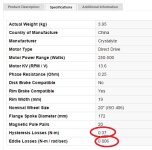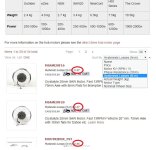John in CR said:
I'd like to see at least 1 no-load current and it's rpm.
We've indirectly published the effective no load current and it's dependency on RPM for all the motors in the "specifications" tab of each motor on our site:

The problem with specifying it as an amperage is that it then becomes dependent on your particular winding. A fast wind motor will have higher no load amps at a given RPM than a slow winding of the same motor, since it needs more amps to achieve the same torque. So it's better to scale the no load amps by the motor's kT term and express it as a no-load torque, and this way you'll get the same results regardless of the winding.
In the above example, a hystersis loss of 0.37 Nm and an eddie loss of 0.006 Nm/V means that the motor drag at 300 rpm would be:
0.37 Nm + 0.006 * 300 rpm * 2Pi / 60 = 0.558 Nm
And since it has a motor kT of (60 / 2Pi /13.6 RPM/V) = 0.702 Nm/A, then the no load current at 300 rpm for this wind would be 0.558 Nm / 0.702 Nm/A = 0.794 amps.
If there's a manufacturers rated power and it's voltage, it could be useful as at least an estimate for calculating it's continuous torque.
I think that the point of this exercise is to do away with manufacturer ratings which can be all over the map, and instead of a normalized means of comparing expected motor performance based on measurable values.
If two motors have exactly the same mass and kV, but one has a resistance of 0.1 ohms, and the other has a resistance of 0.2 ohms, it's clear that the 0.1 ohm version is a *better* motor design, it will produce less heat for the same amount of torque, and with no extra weight. This would manifest itself by a higher Km. If two motors have the same kV and same winding resistance, but one is lighter than the other, then again the lighter motor is a better design and would have a higher specific Km.
If two motors have the same mass, but motor 1 has a winding resistance of 0.1 ohms and a kV of 10 rpm/V, and motor 2 has a resistance of 0.3 ohms and a kV of 5 rpm/V, which is the better design? In this case, for motor 2 to produce the same torque as motor 1, then it requires only halve as much current since it has twice the Kt. But it has 3x the winding resistance, so the total heat generated for a given torque is 3 * (1/2)^2 = 75% lower. Therefor motor 2 is a better better motor, but unlike the other examples it's not immediately apparent without a formula. This is why the square root of R is so important for equalized comparisons.
Now take two motors that have different masses, different kV's, and different resistances, how do you size up which one is *better*? That's what having a normalization parameters between all these variables would do, which my understanding is the goal of specific Km. If you want to size up a motor to see if it is good for a certain power level, then you take the specific Km and multiply it by it's mass again to get Km, and then multiply by your RPM to get some kind of standardized power capability number.
For the Kv and no-load current room to notate if it's with a wheel on, since for some of the more obscure motors we may not be able to get measurements without a wheel, and it makes a significant difference.
That's a good point, although rather than it making a significant difference, I would argue it makes just a slight difference, especially at the modest rpm's of bike wheels. All of the measurements I have provided are for the hub only, not laced in a wheel.
Might as well add stator lamination thickness, motor inductance, and peak efficiency at a stated voltage too so they can be listed if available.
These are all totally irrelevant in a sense, they are mechanical details but what we would care about is how that manifests from measured motor parameters. Manufacturer claimed peak efficiency at a given voltage is also pointless, you can get that derive for any voltage from the known core losses and winding resistance which are terms we already have.
Maybe as part of this process we can come up with a better formula for a motor constant. The specific Km may make comparisons between motors seem better, but I have reservations about Km being a useful number at all. It's definitely not the great equalizer as claimed in one of the links. Resistance squared isn't meaningful, so a formula using the sqrt of resistance can't be either, nor can the sqrt of a watt.
I think it would work like this.
Km gives the basic power class of the motor.
Multiply the Km by your target RPM to get your actual power capability for that motor at that speed.
We could have a chart that relates how many watt/RPM a given Km motor could produce for a given amount of time before overheating.





